 Presented from Issue 107, December 2013
Presented from Issue 107, December 2013
Michal Rybka reveals some deadly Great Lake, kayak based techniques using soft plastic worms. In fact this should not be kayak nor Great Lake limited. If you are a troller of any sort read on.
Worming from a Kayak – a different perspective
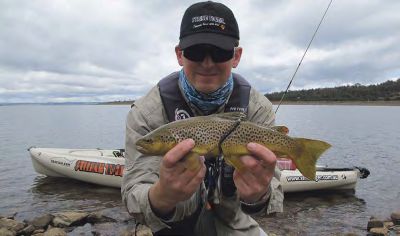 |
| The author, Michal, worming them up |
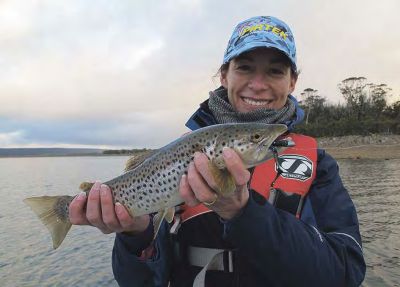 |
| Girls rule – a lovely brownie caught on the troll |
Introduction
Live-worm fishing for trout is one of the oldest and best-known angling methods in Tasmania. It is a popular choice for many anglers who love their set-rod fishing in the Central Highland lakes. In fact ‘worming’, as it is sometimes called, is a very popular method in most parts of the world. Garden worms are inexpensive and a widely available bait favoured not only by trout, but also by many other freshwater species. In many cases, live worms are certainly hard to beat — or are they?
The modern, no mess, no fuss alternative to live worms are worms manufactured from a soft plastic material. While there are many varieties of soft plastic worms specifically designed for set- rod fishing, the type I use when kayak fishing for trout are a little different. While they have some characteristics of a worm, their modified profile provides gives them a swim action, which is even more enticing to fish.
For me, I have found that using such lures from a kayak in the Great Lake works particularly well on the local trout. As with most forms of trout fishing, a successful day relies on finding the right area to target. Finding where trout may feed is the key. You can obviously use your boat to find such areas. You can even try prospecting for trout walking the shoreline. From experience, I can vouch for both methods as they do work well.
But for those of you that like to get even closer to the action (as I do), a kayak is the perfect choice. The stealth element and ability of the kayak to move easily over shallow water will improve your success.
Let me explain.
How to rig a soft plastic worm
Soft plastic worms can be rigged in a variety of ways; however, there are two methods that I tend to use most often. The first uses the standard jighead approach – just as you would rig any other plastic (t-tail, stick bait, curl tail grub). A jighead ranging from 1/12 to 1/16 in weight, with a hook size of 1/0 or size 2 are my preferred choices. The jighead is inserted centrally through the front section of the worm, with the hook exposed at its back.
Some of you may think that trout will grab the tail using this type of setup. But in reality, provided you anticipate the strike and give the fish ample time to ‘suck’ the worm down, you should have no trouble in setting the hook. If you are still worried, you can cut the worm down a bit using your braid scissors. You can even pinch a bit off with your fingers to make the lure shorter to improve hook-up rates.
 |
| An Evolution jighead and hook |
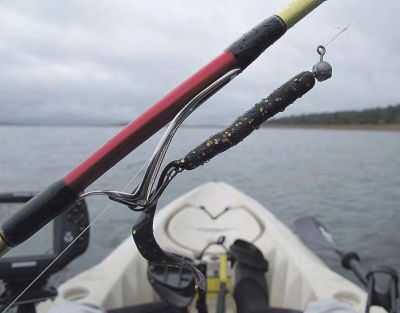 |
| Take great care rigging your worms correctly |
The second method is to use a spine-style jighead in order to position the hook towards the tail section of the worm. Evolution jigheads probably make the best ones for this purpose. This method requires you to insert a skewer centrally through the body of the worm. The skewer is removed and the long jighead, matched to the length of your worm, is inserted through the body of the worm. Finally, a dual hook is clipped onto where the wire end of the jighead comes out near the tail of the worm.
This type of setup will definitely increase your hook-up rate, although, be warned, trout will sometimes go for the head of the worm!
Finish off your setup by using a good rod length of quality fluorocarbon leader material. This should be attached to your main line (braid in most cases) using a good quality leader knot such. Knots that I regularly use are the ‘slim beauty’ and the easier to tie ‘surgeons knot’. Instructions for both can be found on the internet. Tie your jighead onto the leader using a simple loop knot connection. This will ensure that your worm has maximum freedom of movement and therefore a perfect swim action!
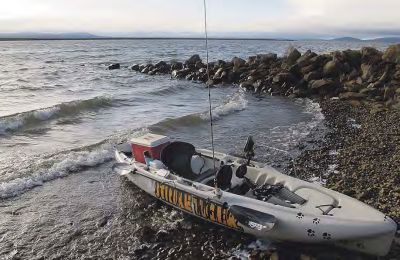 |
| Great Lake is vast, so be prepared |
Kayak Tactics
I will now share a couple of my favourite and effective kayak fishing techniques used for targeting trout. The first relies on finding a wind-blown shore. Great Lake is well known for its wind-blown shores, with large numbers of galaxias often found after getting pounded into the rocks by the waves. These galaxias are an easy meal for a hungry trout, with many simply mopping up the dead fish around these shorelines. Trout will also actively target live galaxias found in shallow shorelines.
The key to this method is to set your kayak up within casting distance of that shoreline. It is even better if you can drift parallel to that shoreline and cover distance at the same time. Once you have positioned yourself, cast your soft plastic worm as close to the waters edge as possible without snagging on the rocks. I then use a ‘rip and pause’ retrieve. As soon as your lure hits the water, simply wind your reel as fast as you can while twitching your rod tip back and forth a few inches. After a few ‘rips’, stop and pause the lure for 2 to 3 seconds, then repeat the sequence over again until the lure comes back to your yak. I have found that, 9 times out of 10, the trout will strike out of aggression on the pause sequence of this retrieve. It therefore pays to anticipate the strike during the pause, a trick that will increase your catch rate!
Prospecting the wind-blown shores in your kayak, as described, should be your first move; however, if you have no success in locating fish this way, try moving away from the shore until your sounder shows a nice drop-off. Let your worm sink to the bottom of the drop off. Then simply use the same ‘rip’ technique that I have described above. Given the increased depth, you can even afford to let the worm pause for longer. If the worm plastic is any good, it should flutter and swim to the bottom during the pause part of the sequence. Again, it’s important to anticipate any takes during this time.
The second kayak technique that I like to use involves finding weed beds that hold fish. The idea here is to swim your worm above the top of the weed bed. For this I use a very lightly weighted worm set up - a 1/16 jighead is perfect for the job. The lighter the setup, the more ‘hang time’ the lure gets. The more ‘hang time’, the more opportunity there is for trout to see your offering. This can only be a good thing!
You will need to start off by locating a suitable weed bed. These can sometimes be a long way from shore. Of course, think about your own safety first before venturing out too far! The sounder fitted to your kayak is your best friend here. Use it to its maximum potential to locate suitable weed beds.
Once you have identified your target, set yourself up within casting distance of the weed bed. You can use the ‘rip’ retrieve over the weed, but I sometimes prefer to just swim the worm slowly across the top of it. To do this, you will need to estimate where the top of the weed is in relation to your lure. Again, use your sounder to help with assessing the height of the weed bed.
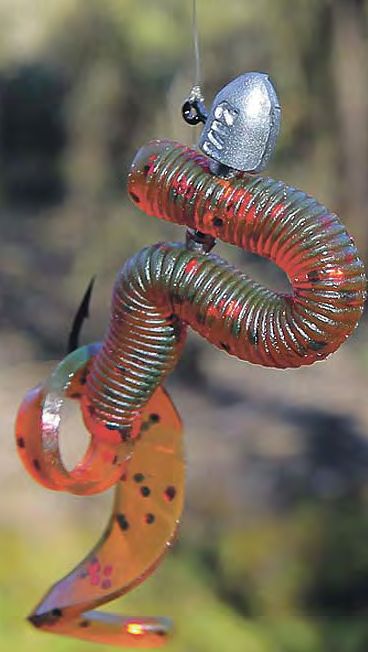 |
|
An incorrectly rigged soft |
Start the retrieve by winding slowly, while very subtly twitching the rod tip back and forth. The rod tip need only be twitched an inch or so either way. Make sure you do it very slowly, while employing a constant, flat retrieve. This will make the worm swim in a fairly flat trajectory above the weed. The added twitch is guaranteed to give your worm a life-like, and therefore, enticing swim action. I sometimes get creative and include a ‘pause’ sequence in this retrieve – just to get some extra special attention!
Conclusion
The techniques that I have described in this story are excellent options for fishing Great Lake; however, they will work on trout just about anywhere, and can be used by anglers of all skill levels. They will work if you are fishing on foot, from the shore, or fishing from a boat or kayak. The advantage of a watercraft like a kayak is that you are able to access those shallow, hard-to-reach places. The added stealth of a kayak will also be a definite bonus when using the methods that I have outlined. If you go about it the right way, you will be able to sneak up on those spooky trout undetected!
Tips
Choosing a shore to target
If you haven’t done your homework regarding the weather and encounter calm conditions on the lake, simply look for fine debris build up on the shoreline. This may consist of, but is not limited to, fine twigs, grass, leaves and even logs. The presence of foam amongst the debris also usually means a recent pounding from the water. This is where you should start!
Choosing a weed bed to target
It pays to remember that weed beds in the Great Lake are home to a variety of aquatic food sources. Here is where a sounder fitted to your kayak can really help you. Look at your sounder carefully and take note of the depth. Aim to find weed that finishes a few metres under the surface. Swimming a lightly weighted soft plastic worm just above the weed line in the water column can be a deadly tactic.
The Swan Bay area contains some excellent weed beds where trout like to take refuge and feed. Tods Corner, although slightly shallower, is another good option. Both areas are generally sheltered from the weather and are well suited to kayak fishing.
Soft plastic worm lure selection
Don’t be afraid to use worm lures that are 4 inches (10 cm +) in length or even a bit longer. Here are some good worm soft plastics that work well at Great Lake:
Strike Tiger Curl Tail Worm, Yep Grimy Gromit, Berkley Gulp Turtleback Worm, Squidgy Pro Worm, Savage Gear Eel, Z man Saw Tail Worm, Gary Yamamoto Senko Worm.
Kayak Safety Tips
- This first point goes without saying – always check the weather. If you get there and it looks risky (if you see whitecaps on the water etc.), then it probably is.
- Take a fishing buddy with you whenever possible to accompany you in another kayak. It’s good practice to stick close to the shore and avoid any crossings over vast expanses of water.
- Think of alternate routes to the launching area should it become rough on the way back. Always wear a good quality PFD – remember it’s the law in Tasmania.
- Take a first aid kit and invest in some flares. Remember, mobile phones have limited reception at Great Lake and in the Central Highlands area. If you are really safety conscious, then invest in a small personal EPIRB.
- The weather can change rapidly. It can even snow up at the lakes in summer!
- Wear warm clothing that will not restrict your ability to operate your craft.
- Take a towel and a change of warm clothes in a dry bag just in case.
- Remember to always take your wet weather gear with you.
- Take plenty of food and water, along with a thermos containing a hot drink.
- Tell someone exactly where you are going and what time you are expected to return.
- And finally, use common sense.
- Don’t take any unnecessary risks.
- A bit on cold water survival
- Having followed all of the above kayak safety tips, you can happily hope for the best.
- However, make sure you are prepared for the worst. The temperature of the water in
- Great Lake can be very cold, even in summer! In many cases, water temperatures that may seem warm can still have an adverse effect on human survival.
- Remember, once you are in cold water, your life is at risk.
- Predicted survival time for a fully clothed adult male wearing a lifejacket in water at 5°C is approximately 1 hour and 2 hours at 10°C – such water temperatures are commonly encountered in our central highland lakes.
- Practice makes good sense
- Probably the best tip I have for those of you who kayak fish (or want to kayak fish) is to practice falling into the water from your kayak in a controlled environment. Do it BEFORE you go fishing! A shallow, but warm sheltered bay somewhere is perfect. You can even try this in a larger swimming pool.
- Wear your PFD and dress as you would when going fishing. It’s also important to take some gear on the kayak that represents the weight that you would normally load it with. Practice getting back on your kayak from the water. Knowing what to expect in such circumstances may save your life one day! You will also realise that everything on board needs to be tied down – rods included!
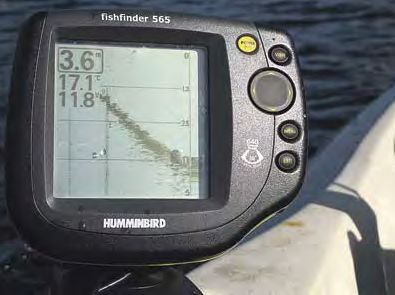 |
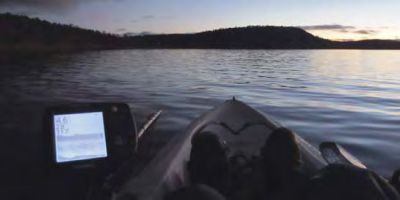 |
| Just like in a boat a fishfinderis your friend. With kayak being much more stealthy you can often sit on top of fish you would never see in a boat. |
Michal Rybka
